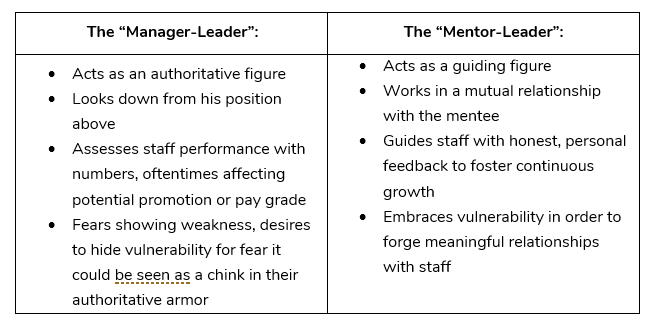
When we look at a handful of service-providing businesses with similar client volume and staff sizes, how do we account for the major differences in their productivity, success, and client experiences? How do we explain why some businesses seem to have it down to a science while others struggle to keep their heads above water? Where is the disconnect? If you’re one of the businesses struggling, you may be asking yourself regularly, what are they doing that I’m not?
CLICK HERE to listen to this article or scroll down to keep reading
After 15 years working as a business transformation specialist and consultant, I can affirm that while I may not know your individual circumstances, I’d be willing to bet that a change in perspective on your leadership approach could stand to improve all of these interrelated areas. This is certainly not to assume or presume that you exhibit poor leadership skills, but rather to assert how strongly I believe in the value of mentor-style leadership over management-style leadership for building and sustaining a thriving business.
Don’t get me wrong, there is a time and place for managerial leadership. Both managers and mentors play vital roles in successful businesses; however, when a business is struggling to create an exceptional client experience and sustain a plan for growth that will allow the businesses to thrive over the long-term, it may be because the office culture has been overly managed and under mentored by those in leadership roles.
Managerial Leadership and Mentorship: What’s the difference?
In order to illuminate the fundamental difference between managing your staff and mentoring your staff, I’d like to reference an idea described by Walter Booker, the learned and astute Chief of Staff at Market Counsel, as the Inside-Out Model of Leadership. In a three-part series of articles published on LinkedIn, Booker describes a style of leadership that originates within the leader and is then extolled outward upon the staff in a way that demonstrates that the staff is a priority and that their contributions are valuable to the organization as a whole. In examining the difference between the typical “results-driven” leader and the Inside-Out leader, Booker explains:
“The challenge is that, too often, organizations and their leaders only focus on (the development and demonstration of) the external, resulting in a milieu replete with leaders who may be efficient in the short term but not sustainably impactful in the long run, who produce strong numbers but not a culture that’s nearly as vibrant as it needs to be to do so consistently over time. Among its other pernicious effects, this approach tends to result in executive burnout and low morale and disengagement among employees/associates.”
In my view, this internal versus external perspective really gets to the heart of the differences between a manager and a mentor and how they affect the staff, which in turn affects the productivity which either makes or breaks the potential for growth.
Where a manager focuses on short-term, numbers driven results, the mentor focuses on cultivating a staff which can also produce those results. Where the manager focuses on dictating tasks down the rungs of the ladder, the mentor seeks to educate the staff in such a way that they can also climb the ladder.

The Cost Benefit Analysis
Of course, each of these styles of leadership comes with costs and benefits, but when the leader demonstrates to his staff through mentorship that he values their roles in the organization, he or she can expect to see:
- Increase in office morale
- Improved inter-office communication
- Smoother buy-in from staff on new ideas
- Staff willingness to Collaborate with passion
- An inspired group of individuals excited to serve their organization
- Increased personal initiative from staff
- An improved client experience
- More free time in his or her own schedule to handle upper level business concerns
Mentoring your staff to take on new roles and head up new initiatives not only benefits them as staff members, but benefits the organization as a whole. When reflecting in Part 2 of his series on his first-hand experience with this type of leadership, Booker explains, “[…] becoming closer to my peeps and thereby being positioned to serve them more impactfully, they, in turn, were able to serve our clients better and our performance improved dramatically both quantitatively and qualitatively. In other words, because we became a more communicative and aligned group, our productivity increased consistently and sustainably while our Client Satisfaction and Employee Engagement scores rose to best-in-class as well. In two words, we got both bigger and better.…”
Of course, anything worth achieving will come with a cost, and when it comes to mentorship, that cost is time. It takes time, most notably on the part of the leader, to create and foster a new company culture centered on higher engagement and increased opportunities for each individual staff member to achieve success.
But when you take the time and money to invest in your staff, the rewards are priceless. The more your staff can do, with passion and purpose, the less you need to do or manage. The more your staff climb, the sooner you will have a succession plan that you can trust and feel comfortable with. And above all, the more that others do to manage the clients and business, the more sane you will become. There is nothing worse than going to work each day and dreading the workload and all the hats you need to wear to keep the firm running smoothly. Overall, investment in your staff is well worth the return. Once the “time debt” has been paid, so to speak, the returns are exponential—not just for the staff or the organization, but for the leader, as well.
Sincerely,
PS. Want to talk more about how I help businesses make progress and operate better? Click HERE. Want to receive my monthly solutions email? Click HERE.







